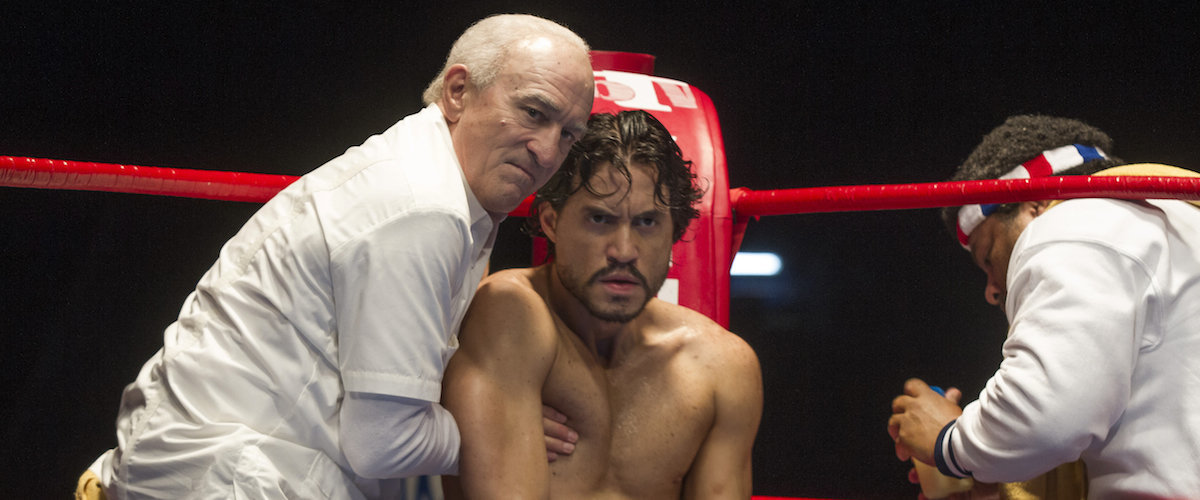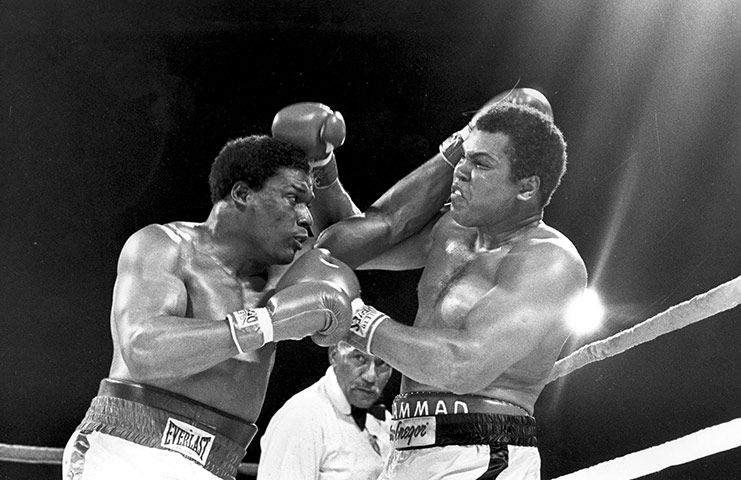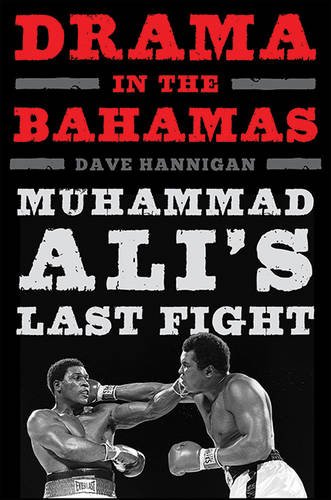by Don Stradley
Roberto Duran had a career that defied easy description– he was a
jaguar in the guise of an alley cat, the fight fans’ fighter, a hero in Panama,
a cult figure in America, putting opponents on the canvas while Ali was
appearing on the Sonny & Cher Comedy Hour – and it’s a disservice to
refer to him as merely a boxing champion. That’s like saying a 44. Magnum is
merely a gun. He once quit in the middle
of an important bout with Sugar Ray Leonard, an act that sent people into spasms of
anger and self-righteousness, especially those who had never been in a fight. But Duran’s charisma was so great that he came back from his faux pas and continued to make money by hitting people in the face and balls. Edgar Ramirez doesn’t quite capture Duran's fierceness in Hands of Stone, but he’s watchable.
In fact, he’s the best thing in a movie that seems designed to present Duran for the politically correct crowd, a Duran without rough edges.
There’s a scene in Hands
of Stone where Duran’s trainer, Ray Arcel (played with sensitivity by Robert De Niro),
comments on the state of boxing. “All of the decisions are made in a
back room,” he says. “Duran was just a circus animal we needed to sell
tickets.” In this glorious mess of a
movie from writer/director Jonathan Jakubowicz, we get such bromides every five
minutes or so. That is, when Arcel isn’t wheezing about boxing being an art, or
Duran isn’t guzzling ice cream. His biggest vice, it seems, was the raspberry slushy.
We see a very young Duran stealing mangoes to feed his family; we see him become a boxing star; we seem him asleep in a pile of Las Vegas strippers. We see him courting his wife, too, and being a family man, because this movie was, after all, partly funded by Panamanian interests; there was probably some incentive to make Duran appear cuddly.
In fact, there's so much white-washing of Duran that some fans may be put off by the whole thing. The most glaring example is the scene where Duran taunts Leonard prior to their first fight. We all know that Duran called Leonard a "maricon", the Spanish slang for homosexual. But that whole bit is cleaned up, made more palatable for the sensitive types who may buy a ticket for a boxing movie. There's no talk from Duran about sending opponents to the morgue, and we never get a sense of what a dirty bastard he could be. Remember, this guy was so crafty he could practically headbutt you in the nuts and get away with it.
Did the film producers feel the movie wouldn't play in America if it stuck to what really happened? The few times we see Duran show some of his fabled nastiness, he immediately apologizes to Arcel, saying something along the lines of "Ah gee, I dunno what comes over me." He sounds like Beaver Cleaver after getting caught stealing cookies. And since when did Duran speak English so well?
We see a very young Duran stealing mangoes to feed his family; we see him become a boxing star; we seem him asleep in a pile of Las Vegas strippers. We see him courting his wife, too, and being a family man, because this movie was, after all, partly funded by Panamanian interests; there was probably some incentive to make Duran appear cuddly.
In fact, there's so much white-washing of Duran that some fans may be put off by the whole thing. The most glaring example is the scene where Duran taunts Leonard prior to their first fight. We all know that Duran called Leonard a "maricon", the Spanish slang for homosexual. But that whole bit is cleaned up, made more palatable for the sensitive types who may buy a ticket for a boxing movie. There's no talk from Duran about sending opponents to the morgue, and we never get a sense of what a dirty bastard he could be. Remember, this guy was so crafty he could practically headbutt you in the nuts and get away with it.
Did the film producers feel the movie wouldn't play in America if it stuck to what really happened? The few times we see Duran show some of his fabled nastiness, he immediately apologizes to Arcel, saying something along the lines of "Ah gee, I dunno what comes over me." He sounds like Beaver Cleaver after getting caught stealing cookies. And since when did Duran speak English so well?
Not only does Jakubowicz want Duran to be nicer than we remember, he wants him to be more famous than we remember. Every crowd shot looks like a Super Bowl half-time show, even when Duran was fighting in dingy old Madison Square Garden, which wasn't exactly a football stadium. The director likes to cut from these big events to
a scene of poor people in Panama gathered around a TV set, but the Panamanians in this
movie are just faceless rabble, as perfunctory as the endless talk about the
Panama Canal. (Some people watching Hands
of Stone may come away thinking Duran fought Leonard for ownership of the
canal. I’m serious.)
When Jakubowicz isn’t injecting his movie with Family Channel plot twists, he’s jamming it with arbitrary weird stuff. For instance, there was a highly unlikely scene where Duran is brought to a prison to take part in a bare-knuckle death match with a gigantic inmate. Then there's singer Usher Raymond in the role of Leonard. Usher isn’t so bad - he appears to take the role seriously - but why are we treated to a scene of Leonard screwing his wife? Was that in case some of Usher’s fans came to the movie and wanted to see his naked ass?
When Jakubowicz isn’t injecting his movie with Family Channel plot twists, he’s jamming it with arbitrary weird stuff. For instance, there was a highly unlikely scene where Duran is brought to a prison to take part in a bare-knuckle death match with a gigantic inmate. Then there's singer Usher Raymond in the role of Leonard. Usher isn’t so bad - he appears to take the role seriously - but why are we treated to a scene of Leonard screwing his wife? Was that in case some of Usher’s fans came to the movie and wanted to see his naked ass?
Strangest of all, though, is John Turturro’s turn as Frankie Carbo, the old mobster who controlled boxing back in the 1950s. According to this movie, Carbo met with Arcel prior to Duran’s fight with Davey Moore. Granted, Carbo had a lot of influence, but I doubt he played a part in this 1983 bout. The son of a bitch had been dead since 1976.






